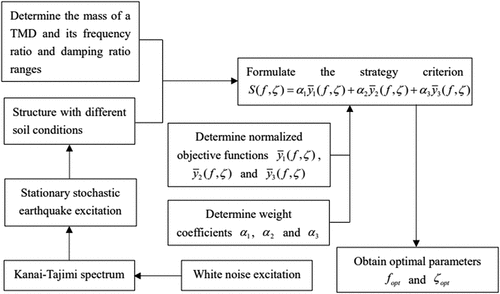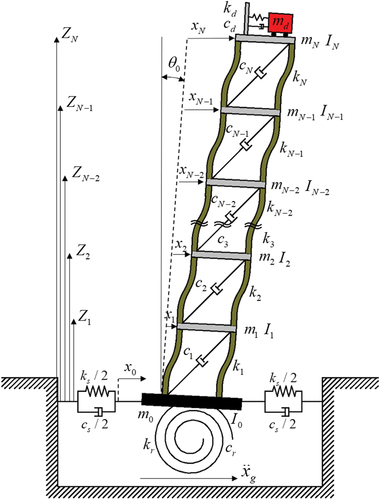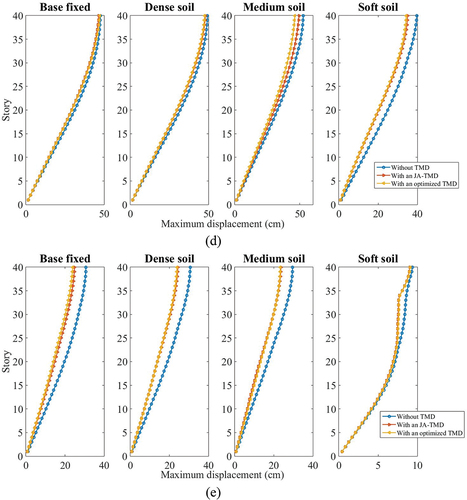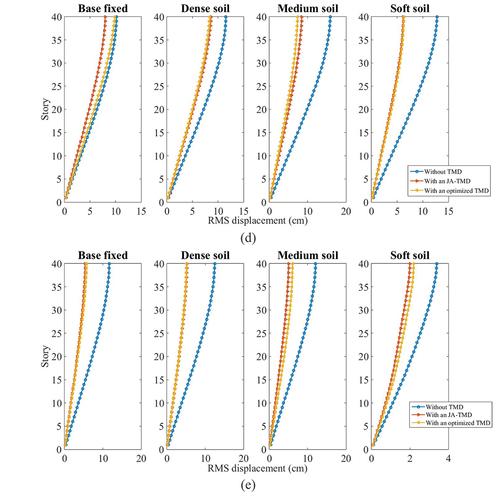 ?Mathematical formulae have been encoded as MathML and are displayed in this HTML version using MathJax in order to improve their display. Uncheck the box to turn MathJax off. This feature requires Javascript. Click on a formula to zoom.
?Mathematical formulae have been encoded as MathML and are displayed in this HTML version using MathJax in order to improve their display. Uncheck the box to turn MathJax off. This feature requires Javascript. Click on a formula to zoom.ABSTRACT
Tuned mass dampers (TMDs) are attractive vibration control devices, and their seismic attenuation depends on their frequency and damping coefficient. Structural characteristics are changed by the soil-structure interaction (SSI); therefore, SSI should be considered in the optimization of TMD. A high-rise building with 40 stories, including four different soil conditions, is proposed as a case study. For the objective function, considering the randomness of earthquakes, a stationary white noise stochastic process based on the Kanai-Tajimi spectrum was used as the input. To improve the performance of a TMD in controlling multimodal and overall dynamic responses, three objectives were considered in the objective function: the maximum and root mean square (RMS) displacements of the top story and the maximum displacement of all stories, respectively. The weight coefficient of each objective function was obtained according to the modal mass participation coefficient. To clearly observe the damping effect of the TMD with different parameter combinations, an ergodic parameter calculation is used. The TMD optimization parameters for each benchmark model with different soil conditions were proposed. Far-field ground motions were considered, and four optimized TMDs from reference were compared. The results show that the proposed TMDs can significantly mitigate earthquake oscillations in a great degree. They performed better than contrastively optimized TMDs under several earthquakes.
1. Introduction
Because of their slender architectural form, high-rise buildings are vulnerable to vibrations. Earthquakes are one of the most dangerous natural disasters affecting tall buildings (Sheng et al. Citation2020, Citation2022; Wang, Shi, and Zhou Citation2022; Wang et al. Citation2022, Citation2023; Zhang, Wang, and Shi Citation2023). Structural control is an effective and economic method for structural earthquake protection (Choi et al. Citation2023; Shi et al. Citation2018), whereas tuned mass dampers (TMD) are attractive controllers (Wang, Zhou, and Shi Citation2023; Wang et al. Citation2023, Citation2020). A TMD can be regarded as a single-degree-of-freedom (DOF) vibration absorber. The basic idea of a TMD is to transfer vibrational energy from the primary structure to itself and dissipate it through a damping element (Shi et al. Citation2019; Wang et al. Citation2021; Wang, Zhou, and Shi Citation0000).
Because of the complexity and randomness of earthquake (Wang et al. Citation2020, Citation2023; Wang, Shi, and Zhou Citation2019), to achieve a good structural control effect, the parameters of a TMD should be optimized. Greco et al. (Greco, Marano, and Fiore Citation2016) optimized a TMD based on performance cost under low-to-moderate earthquakes. Kamgar et al. (Kamgar, Samea, and Khatibinia Citation2018) optimized the parameters of the TMD under critical earthquakes. Lyu et al. (Lyu et al. Citation2020) proposed a shared TMD optimization for a twin-tower structure. Bakre and Jangid (Bakre and Jangid Citation2007) optimized the parameters of the TMD for a damped primary structure. Pozos-Estrada and Gómez (Pozos-Estrada and Gómez Citation2019) presented an optimized TMD for slender monuments under multiple hazards. Leung et al. (Leung and Zhang Citation2009; Leung et al. Citation2008) proposed a particle swarm optimization of a TMD under different excitations. Lavan (Lavan Citation2017) presented a multiobjective optimal TMD design. Matta (Matta Citation2018) proposed lifecycle cost optimization of TMDs for inelastic structures. Keshtegar and Etedali (Keshtegar and Etedali Citation2018) applied an adaptive dynamic harmony search algorithm to optimize the TMDs in nonlinear mathematical models. Bekdaş et al. optimized TMDs using a novel bat algorithm (Bekdaş, Nigdeli, and Yang Citation2018) and harmony search (Bekdaş and Nigdeli Citation2011). Greco and Marano (Greco and Marano Citation2013) optimized the TMDs according to the displacement response and energy dissipation. The application of TMD for structural earthquake mitigation can be found in (Lee et al. Citation2022; Ozturk, Cetin, and Aydin Citation2022; Roozbahan and Jahani Citation2022) as well.
From the references reviewed in the second paragraph, it can be found that first, an optimized TMD can have good earthquake mitigation, and second, for the optimization of TMD parameters, at least three issues should be considered: objective structure, objective function, and optimization algorithm. It is well known that a passive TMD is sensitive to frequency deviation (Wang, Wang, and Shi Citation2021; Shi, Wang, and Lu Citation2018; Wang et al. Citation2019), and a mistuned TMD can even perform negatively in vibration control (Fu et al. Citation2023; Islam, Do, and Kim Citation2018; Wang et al. Citation2020). The soil – structure interaction (SSI) can change the structural characteristics, that is, structural modes, structural frequencies, and damping ratio (Chuai Citation2022; Ganjavi, Gholamrezatabar, and Hajirasouliha Citation2019; Todorovska et al. Citation2020; Yang et al. Citation2023). It was highlighted in (Jia and Jianwen Citation2019) that neglecting SSI would cause performance degradation of TMDs. Therefore, to obtain a robust and effective TMD, SSI should be considered in the objective structure.
A 40-story model proposed in (Liu et al. Citation2008) with four different soil conditions presents a benchmark test bed for the earthquake mitigation optimization of TMDs, while base fixed, dense soil, medium soil, and soft soil models are all considered. In (Bekdaş and Nigdeli Citation2017), proposed by Bekdaş and Nigdeli, the objective function was the minimization of the maximum displacement of the structure and the limitation of the scaled stroke of TMD under several earthquake records, and two metaheuristic algorithms (harmony search and bat algorithms) were used for parameter search. In (Bekdaş et al. Citation2019), authored by Bekdaş et al., the objective function was the minimization of the acceleration transfer function, which did not depend on a specific earthquake and could show great randomization, and several metaheuristic algorithms were used and compared. In (Salvi, Pioldi, and Rizzi Citation2018) presented by Salvi et al., the objective function was the minimization of the root mean square (RMS) displacement of the top story under a special earthquake input, and a classical nonlinear gradient-based optimization algorithm was used to calculate it. In (Farshidianfar and Soheili Citation2013), proposed by Farshidianfar and Soheili, the objective function was to reduce both the maximum displacement and acceleration of stories under the Tabas and Kobe earthquakes, and the ant colony optimization method was utilized. In (Etedali, Akbari, and Seifi Citation2019) authored by Etedali et al., the objective function was focused on the maximum displacement, acceleration, and drift of floors under special near-field earthquakes, and multi-objective cuckoo search algorithm was chosen in the optimization process.
To include SSI in the optimization of TMDs, a 40-story benchmark tall building (Bekdaş and Nigdeli Citation2017; Bekdaş et al. Citation2019; Etedali, Akbari, and Seifi Citation2019; Farshidianfar and Soheili Citation2013; Liu et al. Citation2008; Salvi, Pioldi, and Rizzi Citation2018) is proposed as a case study in this paper. In (Bekdaş et al. Citation2019), it was also shown that different metaheuristic algorithms could obtain similar optimum parameters for TMDs. Therefore, special attention should be paid to this objective function. Considering the randomness of earthquakes, it would be better to use a stochastic earthquake as an input in the optimum process, but not a special earthquake. Additionally, to improve the overall dynamic response mitigation effect of a TMD, both the maximum and RMS responses should be considered. Furthermore, tall buildings may exhibit several modal responses under earthquake excitation. Regard all of these, in this study, a stationary white noise stochastic process based on the Kanai-Tajimi spectrum (Shan et al. Citation2018) is used as the input. To improve the performance of a TMD in controlling multimodal and overall dynamic responses, three objectives were considered in the objective function: the maximum and RMS displacements of the top story and the maximum displacement of all stories, respectively. The weight coefficient of each objective function was obtained according to the modal mass participation coefficient. For a TMD with a constant mass, only its stiffness and damping coefficient must be optimized (Jin et al. Citation2018; Shi et al. Citation2018). To clearly observe the damping effect of the TMD with different parameter combinations, an ergodic parameter calculation is used.
In this study, a multi-objective stochastic optimization of TMDs for high-rise buildings was proposed, which included four different soil conditions. The multi-objective stochastic optimization method is introduced in Section 2. The introduction of the 40-story model and the optimized results are presented in Section 3. In Section 4, 44 far-field ground motions are considered in the numerical simulation and four optimized TMDs from (Bekdaş and Nigdeli Citation2017) are used for comparison. Finally, conclusions and further research are presented in Section 5.
2. Multi-objective stochastic optimization method
2.1. Stochastic dynamic response
For a multiple DOF linear structure, the dynamic equation under base excitation can be written as:
where ,
, and
denote the mass, stiffness, and damping matrices of the structure, respectively.
represents the structural relative displacement matrix, and the overdot is the derivative with respect to time.
Considering the randomness of earthquakes, it would be better to use a stochastic earthquake in the optimal design of TMDs, but not a special earthquake. Therefore, the Tajimi spectrum (Chen et al. Citation2016) is presented in this study.
where and
indicate the dominant frequency and damping ratio of the soil, respectively;
is the excitation frequency; and
represents a constant intensity.
A stationary white noise stochastic process based on EquationEquation (2)(2)
(2) was used as the input in the following case study, while
and
were set to
and 0.6, respectively.
2.2. Multi-objective optimization
Typically, the TMD mass ratio is set to 1%–5%. After determining the mass ratio, this study focused on the optimization of the frequency ratio and damping ratio
.
The optimization results and earthquake mitigation effect mainly depend on the objective function . To improve the overall earthquake mitigation effect of a TMD, a multiobjective function is proposed in this section. Excessive displacement responses endanger the structure under earthquake excitations; therefore, both the maximum and RMS displacement responses are considered. A tall building may exhibit several modal responses under earthquake excitation. To enhance the control effect of a TMD in controlling multimodal and overall dynamic responses, the third objective function was chosen to be the maximum displacement of all stories. The weight coefficient
of each objective function
is obtained according to the modal mass participation coefficient, and the first two modes are usually considered to be sufficient.
The ith objective function is written in a normalized form (Chen et al. Citation2016):
where and
are the maximum and minimum values, respectively, of the ith function. Then, it can be known that the performance is better when
is closer than one.
The ith weight coefficient of each normalized objective function
can be obtained according to the modal mass participation coefficient. For the first two functions, which are the minimum of the maximum and RMS displacement responses of the top story,
and
are both half of the ratio of the first-order mass participation coefficient to the previous two order mass participation coefficients. Then, for the third objective, which is the minimum of the maximum displacement of all stories,
is the ratio of the second-order mass participation coefficient to the previous two order mass participation coefficients.
It should be noted that the first two objective functions are focused on the structural first mode, whereas the third focuses on the second mode. If a structure has only the first modal response, then the third function is virtually the same as the first function.
Therefore, the strategy criterion proposed in this study can be written as:
A flowchart of the proposed multi-objective stochastic optimization method is illustrated in .
It should be noted that the proposed optimization method is suitable and applicable to buildings in which SSI is ignored or considered, as shown in the following case study.
3. Case study
To present the optimization process and results of the proposed multi-objective stochastic optimization method, a 40-story high-rise building is proposed in this section. Four different soil conditions were considered in this benchmark problem. The first is a base fixed model that ignores the SSI and is a normal shear-type MDOF structure. The other three models considered the SSI with different types of soil.
3.1. Model description
A 40-story high-rise building with SSI installed with a TMD is illustrated in .
In , ,
and
are the mass, stiffness and damping coefficients of TMD respectively;
is the total number of stories, which is 40 in this study;
,
and
mean the mass, stiffness and damping coefficients of ith story respectively;
and
are the mass and mass moment of inertia of the foundation respectively, while
is the mass moment of inertia of the ith story; as for soil parameters,
and
are the swaying parameters respectively, while
and
represent the rocking parameters respectively;
and
are relative displacements of the foundation and ith story respectively, while
is the rotation of the foundation;
is the height of the ith story, and
is the earthquake input.
Detailed information, parameters, dynamic equations, and matrices for this model can be found in (Bekdaş and Nigdeli Citation2017; Bekdaş et al. Citation2019; Jia and Jianwen Citation2019; Liu et al. Citation2008; Salvi, Pioldi, and Rizzi Citation2018; Yang et al. Citation2023). For brevity, they are not repeated here. The model without TMD, ignoring the SSI, is a normal shear-type 40 DOF structure. As for models including SSI, ,
,
, and
are different and can be found in (Bekdaş and Nigdeli Citation2017; Bekdaş et al. Citation2019; Jia and Jianwen Citation2019; Liu et al. Citation2008; Salvi, Pioldi, and Rizzi Citation2018; Yang et al. Citation2023) too. Therefore, when the SSI is considered and a TMD is implemented, it has a 43 DOF structure.
Numerical models were built according to these parameters, dynamic equations, and matrices in MATLAB. The first-order frequencies of the four models are 0.2626, 0.2562, 0.2451, and 0.1735 Hz, respectively, according to the model analysis, similar to the results in (Bekdaş and Nigdeli Citation2017; Bekdaş et al. Citation2019; Jia and Jianwen Citation2019; Liu et al. Citation2008; Salvi, Pioldi, and Rizzi Citation2018; Yang et al. Citation2023), which shows the accuracy of the built mathematical model.
Through model analysis of the base fixed model, it can be seen that the first two order mass participation coefficients were 0.7866 and 0.1058, respectively. Therefore, in EquationEquation (4)(4)
(4) , the weight coefficients are
.
3.2. Optimization results
According to the multi-objective stochastic optimization method proposed in , four TMDs were specifically optimized for the four models.
In (Bekdaş et al. Citation2019), the objective function was the minimization of the acceleration transfer function, which did not depend on a specific earthquake and could show great randomization. Several metaheuristic algorithms were used and compared. It was found in (Bekdaş et al. Citation2019) that the Jaya (JA) algorithm is an effective and robust method for finding the best parameters. Therefore, the JA-TMDs proposed in (Bekdaş et al. Citation2019) were used for the earthquake mitigation comparisons in Section 4. Similar to JA-TMDs, the mass of the TMD was set to 784 t in this study. In the parameter search, the TMD frequency ratio range was 0.90 ~ 1.10, and the damping ratio range was 0.0500 ~ 0.1600.
The optimization results and comparative JA-TMDs are proposed and compared in .
Table 1. Proposed TMDs and comparative TMDs.
To highlight the overall structural control effect of the optimized TMDs under stationary white noise stochastic excitation, comparisons of the displacement responses of every story in the four control cases are presented in .
Figure 3. Comparisons of displacement responses of every story. (a) maximum displacement; (b) RMS displacement.
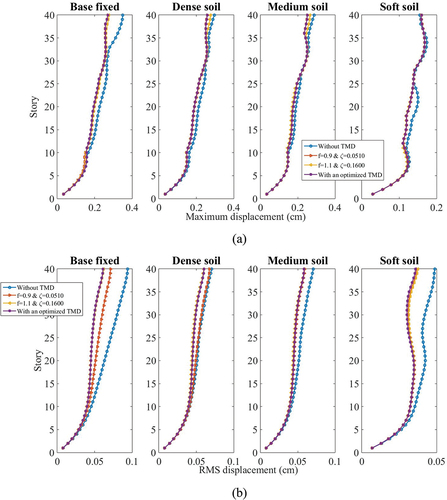
It can be seen in that first, it is clear that the optimized TMD has the best structural control effect, regardless of the maximum or RMS displacements. It is interesting to note that the building has several modal responses, particularly the model with soft soil, as shown in . In this model, the maximum displacement appeared on the 34th floor. The optimized TMD can decrease the maximum displacement on the 34th floor, which is the focus of the third objective function, but it increases the maximum displacement in the top story to a small degree. It can be concluded that the optimized TMD achieves a balance in multimodal response control.
4. Numerical results and discussion
4.1. Responses comparisons of the top story
44 far-field ground motions (two components of 22 stations) (Bekdaş and Nigdeli Citation2017; Bekdaş et al. Citation2019) with maximum amplitudes normalized to 1 m/s2 were used to verify the earthquake mitigation of the proposed TMDs. These data were downloaded from (CitationPacific Earthquake Engineering Research Center PEER Ground Motion Database). The displacement responses of the top story of the two TMD cases of the base fixed structure and the model with soft soil are presented in , respectively, while the displacement and acceleration responses of the four models without TMD, with an optimized TMD case, and with a comparative JA-TMD case, respectively, are illustrated in . Meanwhile, the reductions in the proposed TMD are shown in as well, compared to the other two cases.
Figure 4. Displacements responses reductions of proposed TMDs in the benchmark high-rise building with different soil condition. (a) &; (b) maximum and RMS displacements compared to the case without TMD; (c) &; (d) maximum and RMS displacements compared to the JA-TMD case.
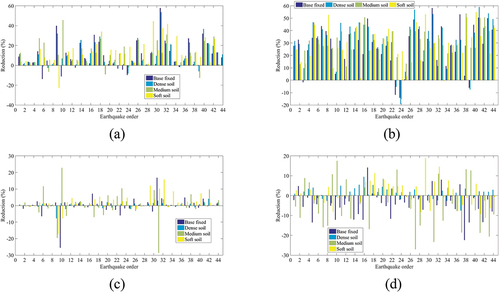
Figure 5. Accelerations responses reductions of proposed TMDs in the benchmark high-rise building with different soil condition. (a) &; (b) maximum and RMS accelerations compared to the case without TMD; (c) &; (d) maximum and RMS accelerations compared to the JA-TMD case.
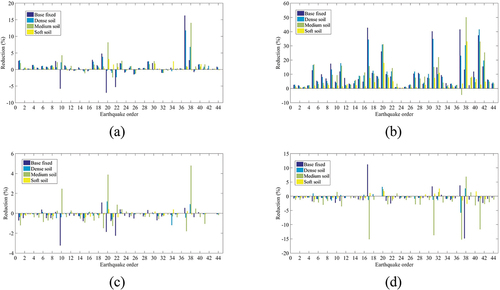
Table 2. Displacement response of the base fixed model.
Table 3. Displacement response of the soft soil model.
From , , because of the randomness and complexity of earthquakes, there is a significant difference in the structural displacement and acceleration responses and control effects of TMDs. Compared to the structure without the controller, the optimized TMD has satisfactory earthquake mitigation in displacement and acceleration RMS responses; the reduction in the maximum response is not as obvious as the RMS response, and the reduction in maximum displacement is better than acceleration. Compared with JA-TMDs, under some earthquakes, the proposed TMDs have a better performance, but they are generally comparable. Because comparative JA-TMDs are also specially optimized, the effectiveness of the optimization method proposed in this paper can be verified.
To clearly observe the control effect in the time history, the No. 19 Y-directional earthquake, which is the “CHICHI/CHY101-N” component of “Chi-Chi, Taiwan” motion, as an example, the displacement responses of the top story are presented and compared in .
Figure 6. Comparisons of displacement responses of the top story under the elected earthquake. (a) base fixed; (b) dense soil; (c) medium soil; (d) soft soil.
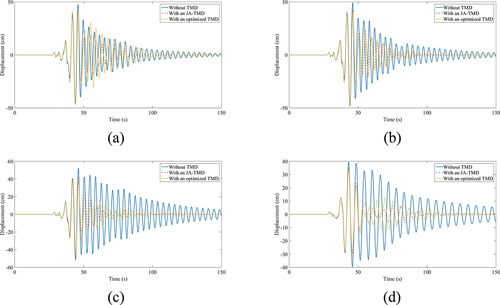
As shown in , in the base fixed model, the proposed TMD was not as effective as the JA-TMD. However, in the other three models considering SSI, the proposed optimized TMDs exhibit better performance than JA-TMDs. Especially in medium soil and soft soil models, the proposed TMDs can significantly decrease the displacement responses of the top story in a great degree.
4.2. Structural responses comparisons
To evaluate the overall earthquake mitigation, five earthquake motions that can cause large dynamic responses in and were chosen and are listed in (Jia and Jianwen Citation2019; Liu et al. Citation2008). The maximum and RMS displacement response comparisons for each story are shown in and respectively.
Figure 7. Comparisons of maximum displacement responses of every story. (a) maximum displacement under No. 9 FN earthquake; (b) maximum displacement under No. 10 FP earthquake; (c) maximum displacement under No. 19 FN earthquake; (d) maximum displacement under No. 19 FP earthquake; (e) maximum displacement under No. 21 FN earthquake.
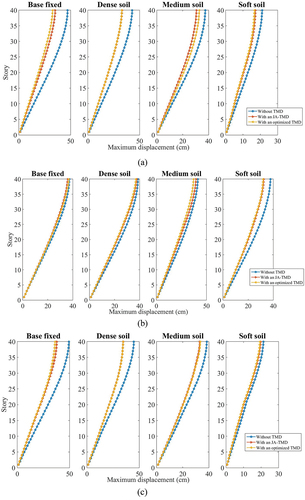
Figure 8. Comparisons of RMS displacement responses of every story. (a) RMS displacement under No. 9 FN earthquake; (b) RMS displacement under No. 10 FP earthquake; (c) RMS displacement under No. 19 FN earthquake; (d) RMS displacement under No. 19 FP earthquake; (e) RMS displacement under No. 21 FN earthquake.
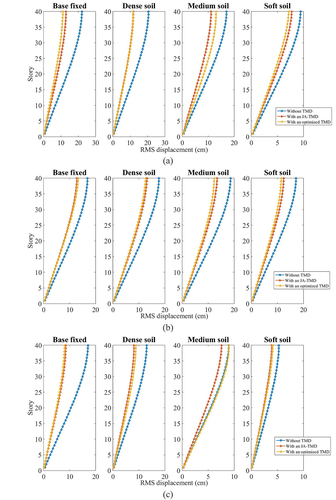
Table 4. The considered five earthquake motions.
and show that under these five earthquake excitations, which can cause relatively large dynamic responses, the first modal response is dominant. Under the No. 9 FN earthquake, the proposed TMD performs better than the JA-TMD in the base fixed and soft soil models; they perform similarly in the dense soil model, and in the medium soil model, the JA-TMD performs better and they are generally similar. Under the No. 10 FP earthquake, except for the base fixed model, the TMDs proposed in this study have a better control effect than the JA-TMDs. Under the No. 19 FN earthquake, as for the maximum displacement, they have a similar performance; for the RMS displacement, JA-TMDs have a better earthquake mitigation in dense soil and medium soil models, and their performances are similar in the base fixed and soft soil models. Under the No. 19 FP earthquake, as for the maximum displacement, the proposed TMD has a better control effect in the medium soil model, and they perform similarly in the other three models. For the RMS displacement, the JA-TMD performs better in the base fixed model, whereas the proposed TMD has a better performance in the medium soil model. Finally, under the No. 21 FN earthquake, they generally had a comparable control effect.
5. Conclusions
Considering the complexity and randomness of earthquakes, to achieve a good earthquake mitigation, the parameters of TMD should be optimized specially and a multi-objective stochastic optimization method is proposed in this paper. SSI can change the structural characteristics and the neglect of SSI may lead to a performance degradation of TMDs. A benchmark 40-story high-rise building with four different soil conditions is proposed as a case study. A stationary white noise stochastic excitation based on the Kanai-Tajimi spectrum is used as the input in the optimal design. Three objectives are considered in the objective function, which are the maximum and RMS displacements of the top story and the maximum displacement of all stories respectively. The weight coefficient of each objective function is obtained according to the modal mass participation coefficient.
The TMD optimization parameters for every model with different soil conditions were proposed. 44 far-field ground motions were considered in the simulation to verify earthquake mitigation, and four JA-TMDs from (Bekdaş et al. Citation2019) were used for comparison. From this study, it can be concluded that:
The proposed multi-objective stochastic optimization method can cover the maximum and RMS displacement responses of the first mode and the maximum displacement response of the second mode and is suitable for buildings that ignore or consider SSI. In addition, it is based on a stationary stochastic earthquake excitation, which contributes to its wide applicability. Therefore, it can be concluded that the proposed method and optimized TMD has a better robust and is suitable for different structures.
Compared to the case without TMD, the proposed optimized TMDs can mitigate earthquake oscillations to a great degree, both in terms of displacement and acceleration responses, and maximum and RMS responses. It has a better earthquake mitigation performance and effect.
Under several earthquakes, the proposed TMDs perform better than the contrastive JA-TMDs, and both have excellent earthquake mitigation performance. Therefore, the proposed optimized TMD can protect a tall building from different earthquake excitations very effectively.
In future research, different optimization algorithms can be used to optimize the parameters of TMD, different optimization objectives can be considered, nonlinear structures are worth studying, multiple TMD systems are worth exploring, semi-active and active TMD are also worth studying.
Acknowledgements
The authors are grateful for the financial support received from the formation mechanism and countermeasures of “the Belt and Road power investment project safety cost (17BGL010).
Disclosure statement
No potential conflict of interest was reported by the author(s).
Data availability statement
Data will be made available on request.
Additional information
Funding
Notes on contributors
Yang Wang
Yang Wang, male, associate professor, Doctor of Engineering, graduated from College of Civil Engineering in Tongji University in 2008. Currently, he is the Director of the Department of Engineering Management, Shanghai Electric Power University. His research interests include seismic reduction and health monitoring of engineering structures, intelligent construction and innovation, and building carbon emission management. E-mail: [email protected].
Haotian Ma
Haotian Ma, male, is currently studying for a master’s degree in the School of Economics and Management of Shanghai Electric Power University. He is a member of the digital intelligent construction laboratory. His research activities have centered on energy system resilience, short-term power forecasting, energy system optimization. E-mail: [email protected].
References
- Bakre, S. V., and R. S. Jangid. 2007. “Optimum Parameters of Tuned Mass Damper for Damped Main System.” Structural Control and Health Monitoring 14 (3): 448–470. https://doi.org/10.1002/stc.166.
- Bekdaş, G., A. E. Kayabekir, S. M. Nigdeli, and Y. C. Toklu. 2019. “Tranfer Function Amplitude Minimization for Structures with Tuned Mass Dampers Considering Soil-Structure Interaction.” Soil Dynamics and Earthquake Engineering 116:552–562. https://doi.org/10.1016/j.soildyn.2018.10.035.
- Bekdaş, G., and S. M. Nigdeli. 2011. “Estimating Optimum Parameters of Tuned Mass Dampers Using Harmony Search.” Engineering Structures 33 (9): 2716–2723. https://doi.org/10.1016/j.engstruct.2011.05.024.
- Bekdaş, G., and S. M. Nigdeli. 2017. “Metaheuristic Based Optimization of Tuned Mass Dampers Under Earthquake Excitation by Considering Soil-Structure Interaction.” Soil Dynamics and Earthquake Engineering 92:443–461. https://doi.org/10.1016/j.soildyn.2016.10.019.
- Bekdaş, G., S. M. Nigdeli, and X. S. Yang. 2018. “A Novel Bat Algorithm Based Optimum Tuning of Mass Dampers for Improving the Seismic Safety of Structures.” Engineering Structures 159:89–98. https://doi.org/10.1016/j.engstruct.2017.12.037.
- Chen, X., H. T. Y. Yang, J. Z. Shan, P. K. Hansma, and W. Shi. 2016. “Bio-Inspired Passive Optimized Base-Isolation System for Seismic Mitigation of Building Structures.” Journal of Engineering Mechanics 142 (1): 04015061. https://doi.org/10.1061/(ASCE)EM.1943-7889.0000971.
- Choi, J., D. S. Kang, M. G. Lee, S. G. Bae, T. Hong, D. E. Lee, H. S. Park, et al. 2023. “Vibration Safety Evaluation Model and Sensor Network-Based Monitoring System for Coke Drums in Operation.” Journal of Asian Architecture and Building Engineering 22 (3): 1399–1412. https://doi.org/10.1080/13467581.2022.2085719.
- Chuai, M. 2022. “Numerical Simulation of Shaking Table Tests on a Soil Structure System.” Journal of Asian Architecture and Building Engineering 21 (3): 1002–1018. https://doi.org/10.1080/13467581.2021.1927047.
- Etedali, S., M. Akbari, and M. Seifi. 2019. “MOCS-Based Optimum Design of TMD and FTMD for Tall Buildings Under Near-Field Earthquakes Including SSI Effects.” Soil Dynamics and Earthquake Engineering 119:36–50. https://doi.org/10.1016/j.soildyn.2018.12.027.
- Farshidianfar, A., and S. Soheili. 2013. “Ant Colony Optimization of Tuned Mass Dampers for Earthquake Oscillations of High-Rise Structures Including Soil–Structure Interaction.” Soil Dynamics and Earthquake Engineering 51:14–22. https://doi.org/10.1016/j.soildyn.2013.04.002.
- Fu, B., X. X. Wei, J. Chen, and S. Bi. 2023. “Shear Lag Effects on Pedestrian-Induced Vibration and TMD-Based Vibration Control of Footbridges.” Structural Engineering International 33 (3): 447–461. https://doi.org/10.1080/10168664.2022.2059799.
- Ganjavi, B., A. Gholamrezatabar, and I. Hajirasouliha. 2019. “Effects of Soil-Structure Interaction and Lateral Design Load Pattern on Performance-Based Plastic Design of Steel Moment Resisting Frames.” The Structural Design of Tall & Special Buildings 28 (11): e1624. https://doi.org/10.1002/tal.1624.
- Greco, R., and G. C. Marano. 2013. “Optimum Design of Tuned Mass Dampers by Displacement and Energy Perspectives.” Soil Dynamics and Earthquake Engineering 49:243–253. https://doi.org/10.1016/j.soildyn.2013.02.013.
- Greco, R., G. C. Marano, and A. Fiore. 2016. “Performance–Cost Optimization of Tuned Mass Damper Under Low-Moderate Seismic Actions.” The Structural Design of Tall & Special Buildings 25 (18): 1103–1122. https://doi.org/10.1002/tal.1300.
- Islam, M. S., J. Do, and D. Kim. 2018. “Multi-Objective Optimization of TMD for Frame Structure Based on Response Surface Methodology and Weighted Desirability Function.” KSCE Journal of Civil Engineering 22 (8): 3015–3027. https://doi.org/10.1007/s12205-017-0387-2.
- Jia, F., and L. Jianwen. 2019. “Performance Degradation of Tuned-Mass-Dampers Arising from Ignoring Soil-Structure Interaction Effects.” Soil Dynamics and Earthquake Engineering 125:105701. https://doi.org/10.1016/j.soildyn.2019.05.040.
- Jin, X., S. Y. Xie, J. He, Y. Lin, Y. Wang, and N. Wang. 2018. “Optimization of Tuned Mass Damper Parameters for Floating Wind Turbines by Using the Artificial Fish Swarm Algorithm.” Ocean Engineering 167:130–141. https://doi.org/10.1016/j.oceaneng.2018.08.031.
- Kamgar, R., P. Samea, and M. Khatibinia. 2018. “Optimizing Parameters of Tuned Mass Damper Subjected to Critical Earthquake.” The Structural Design of Tall & Special Buildings 27 (7): e1460. https://doi.org/10.1002/tal.1460.
- Keshtegar, B., and S. Etedali. 2018. “Nonlinear Mathematical Modeling and Optimum Design of Tuned Mass Dampers Using Adaptive Dynamic Harmony Search Algorithm.” Structural Control and Health Monitoring 25 (7): e2163. https://doi.org/10.1002/stc.2163.
- Lavan, O. 2017. “Multi-Objective Optimal Design of Tuned Mass Dampers.” Structural Control & Health Monitoring 24 (11): e2008. https://doi.org/10.1002/stc.2008.
- Lee, B., C. Chen, T. Chen, S.-Y. Shiao, C.-R. Jiang, and F. Y. Yeh. 2022. “Enhancement of Structural Seismic Performance of Low-Rise Buildings Using Displacement-Dependent Tuned Mass Damper.” Structures 37:1119–1128. https://doi.org/10.1016/j.istruc.2022.01.051.
- Leung, A. Y. T., and H. J. Zhang. 2009. “Particle Swarm Optimization of Tuned Mass Dampers.” Engineering Structures 31 (3): 715–728. https://doi.org/10.1016/j.engstruct.2008.11.017.
- Leung, A. Y. T., H. J. Zhang, C. C. Cheng, and Y. Y. Lee. 2008. “Particle Swarm Optimization of TMD by Non-Stationary Base Excitation During Earthquake.” Earthquake Engineering and Structural Dynamics 37 (9): 1223–1246. https://doi.org/10.1002/eqe.811.
- Liu, M. Y., W. L. Chiang, J. H. Hwang, and C. R. Chu. 2008. “Wind-Induced Vibration of High-Rise Building with Tuned Mass Damper Including Soil–Structure Interaction.” Journal of Wind Engineering and Industrial Aerodynamics 96 (6–7): 1092–1102. https://doi.org/10.1016/j.jweia.2007.06.034.
- Lyu, Q., W. Lu, W. Wang, and Y. Chen. 2020. “Mechanism and Optimum Design of Shared Tuned Mass Damper for Twin-Tower Structures Connected at the Top by an Isolated Corridor.” The Structural Design of Tall & Special Buildings 29 (8): e1728. https://doi.org/10.1002/tal.1728.
- Matta, E. 2018. “Lifecycle Cost Optimization of Tuned Mass Dampers for the Seismic Improvement of Inelastic Structures.” Earthquake Engineering and Structural Dynamics 47 (3): 714–737. https://doi.org/10.1002/eqe.2987.
- Ozturk, B., H. Cetin, and E. Aydin. 2022. “Optimum Vertical Location and Design of Multiple Tuned Mass Dampers Under Seismic Excitations.” Structures 41:1141–1163. https://doi.org/10.1016/j.istruc.2022.05.014.
- Pacific Earthquake Engineering Research Center (PEER Ground Motion Database). 2013. https://ngawest2.berkeley.edu.
- Pozos-Estrada, A., and R. Gómez. 2019. “Parametric Study of the Use and Optimization of Tuned Mass Dampers to Control the Wind‐ and Seismic‐Induced Responses of a Slender Monument.” The Structural Design of Tall & Special Buildings 28 (13): e1633. https://doi.org/10.1002/tal.1633.
- Roozbahan, M., and E. Jahani. 2022. “Optimal Design of Elastic and Elastoplastic Tuned Mass Dampers Using the Mouth Brooding Fish Algorithm for Linear and Nonlinear Structures.” Structures 43:1084–1090. https://doi.org/10.1016/j.istruc.2022.07.037.
- Salvi, J., F. Pioldi, and E. Rizzi. 2018. “Optimum Tuned Mass Dampers Under Seismic Soil-Structure Interaction.” Soil Dynamics and Earthquake Engineering 114:576–597. https://doi.org/10.1016/j.soildyn.2018.07.014.
- Shan, J. Z., Z. G. Shi, F. Hu, J. Yu, and W. Shi. 2018. “Stochastic Optimal Design of Novel Nonlinear Base Isolation System for Seismic-Excited Building Structures.” Structural Control and Health Monitoring 25 (7): e2168. https://doi.org/10.1002/stc.2168.
- Sheng, T., G. B. Liu, X. C. Bian, W.-X. Shi, and Y. Chen. 2022. “Development of a Three-Directional Vibration Isolator for Buildings Subject to Metro- and Earthquake-Induced Vibrations.” Engineering Structures 252:113576. https://doi.org/10.1016/j.engstruct.2021.113576.
- Sheng, T., W. Shi, J. Shan, F. Y. Hong, X. C. Bian, G. B. Liu, Y. Chen, et al. 2020. “Base Isolation of Buildings for Subway-Induced Environmental Vibration: Field Experiments and a Semi-Analytical Prediction Model.” The Structural Design of Tall & Special Buildings 29 (16): e1798. https://doi.org/10.1002/tal.1798.
- Shi, W., L. Wang, and Z. Lu. 2018. “Study on Self-Adjustable Tuned Mass Damper with Variable Mass.” Structural Control and Health Monitoring 25 (3): e2114. https://doi.org/10.1002/stc.2114.
- Shi, W., L. Wang, Z. Lu, and H. Gao. 2018. “Study on Adaptive-Passive and Semi-Active Eddy Current Tuned Mass Damper with Variable Damping.” Sustainability 10 (2): 99. https://doi.org/10.3390/su10010099.
- Shi, W., L. Wang, Z. Lu, and H. Wang. 2019. “Experimental and Numerical Study on Adaptive-Passive Variable Mass Tuned Mass Damper.” Journal of Sound and Vibration 452:97–111. https://doi.org/10.1016/j.jsv.2019.04.008.
- Shi, W., L. Wang, Z. Lu, and Q. Zhang. 2018. “Application of an Artificial Fish Swarm Algorithm in an Optimum Tuned Mass Damper Design for a Pedestrian Bridge.” Applied Sciences 8 (2): 175. https://doi.org/10.3390/app8020175.
- Todorovska, M. I., B. Niu, G. Lin, C. Cao, D. Wang, J. Cui, F. Wang, et al. 2020. “A New Full-Scale Testbed for Structural Health Monitoring and Soil–Structure Interaction Studies: Kunming 48-Story Office Building in Yunnan Province, China.” Structural Control and Health Monitoring 27 (7): e2545. https://doi.org/10.1002/stc.2545.
- Wang, L., S. Nagarajaiah, W. Shi, and Y. Zhou. 2020. “Study on Adaptive-Passive Eddy Current Pendulum Tuned Mass Damper for Wind-Induced Vibration Control.” The Structural Design of Tall & Special Buildings 29 (15): e1793. https://doi.org/10.1002/tal.1793.
- Wang, L., S. Nagarajaiah, W. Shi, and Y. Zhou. 2021. “Semi-Active Control of Walking-Induced Vibrations in Bridges Using Adaptive Tuned Mass Damper Considering Human-Structure-Interaction.” Engineering Structures 244:112743. https://doi.org/10.1016/j.engstruct.2021.112743.
- Wang, L., S. Nagarajaiah, W. Shi, and Y. Zhou. 2022. “Seismic Performance Improvement of Base-Isolated Structures Using a Semi-Active Tuned Mass Damper.” Engineering Structures 271:114963. https://doi.org/10.1016/j.engstruct.2022.114963.
- Wang, L., S. Nagarajaiah, Y. Zhou, and W. Shi. 2023. “Experimental Study on Adaptive-Passive Tuned Mass Damper with Variable Stiffness for Vertical Human-Induced Vibration Control.” Engineering Structures 280:115714. https://doi.org/10.1016/j.engstruct.2023.115714.
- Wang, L., W. Shi, and Y. Zhou. 2019. “Study on Self-Adjustable Variable Pendulum Tuned Mass Damper.” The Structural Design of Tall & Special Buildings 28 (1): e1561. https://doi.org/10.1002/tal.1561.
- Wang, L., W. Shi, and Y. Zhou. 2022. “Adaptive-Passive Tuned Mass Damper for Structural Aseismic Protection Including Soil–Structure Interaction.” Soil Dynamics and Earthquake Engineering 158:107298. https://doi.org/10.1016/j.soildyn.2022.107298.
- Wang, L., Y. Zhou, S. Nagarajaiah, and W. Shi. 2023. “Bi-Directional Semi-Active Tuned Mass Damper for Torsional Asymmetric Structural Seismic Response Control.” Engineering Structures 294:116744. https://doi.org/10.1016/j.engstruct.2023.116744.
- Wang, L., Y. Zhou, and W. Shi. 2023. “Seismic Response Control of a Nonlinear Tall Building Under Mainshock-Aftershock Sequences Using Semi-Active Tuned Mass Damper.” International Journal of Structural Stability and Dynamics. https://doi.org/10.1142/S0219455423400278.
- Wang, L., Y. Zhou, and W. Shi. 2023. “Seismic Control of a Smart Structure with Semiactive Tuned Mass Damper and Adaptive Stiffness Property.” Earthquake Engineering and Resilience 2 (1): 74–93. https://doi.org/10.1002/eer2.38.
- Wang, L. K., W. X. Shi, X. W. Li, Q. Zhang, and Y. Zhou. 2019. “An Adaptive-Passive Retuning Device for a Pendulum Tuned Mass Damper Considering Mass Uncertainty and Optimum Frequency.” Structural Control and Health Monitoring 26 (7): e2377. https://doi.org/10.1002/stc.2377.
- Wang, L. K., W. X. Shi, Q. W. Zhang, and Y. Zhou. 2020. “Study on Adaptive-Passive Multiple Tuned Mass Damper with Variable Mass for a Large-Span Floor Structure.” Engineering Structures 209:110010. https://doi.org/10.1016/j.engstruct.2019.110010.
- Wang, L. K., W. X. Shi, Y. Zhou, and Q. Zhang. 2020. “Semi-Active Eddy Current Pendulum Tuned Mass Damper with Variable Frequency and Damping.” Smart Structures and Systems 25 (1): 65–80.
- Wang, M., F. F. Sun, Y. Koetaka, L. Chen, S. Nagarajaiah, and X. L. Du. 2023. “Frequency Independent Damped Outrigger Systems for Multi-Mode Seismic Control of Super Tall Buildings with Frequency Independent Negative Stiffness Enhancement.” Earthquake Engineering and Structural Dynamics 52 (9): 2731–2754. https://doi.org/10.1002/eqe.3891.
- Wang, Y., L. Wang, and W. Shi. 2021. “Two-Dimensional Air Spring Based Semi-Active TMD for Vertical and Lateral Walking and Wind-Induced Vibration Control.” Structural Engineering and Mechanics 80 (4): 377–390.
- Yang, J., F. Zhang, P. Li, and H. Jing. 2023. “Seismic Performance of Column-Bearing Silo Structure with Granular Materials Considering SSI Effect.” Structures 47:595–606. https://doi.org/10.1016/j.istruc.2022.11.064.
- Zhang, H., L. Wang, and W. Shi. 2023. “Seismic Control of Adaptive Variable Stiffness Intelligent Structures Using Fuzzy Control Strategy Combined with LSTM.” Journal of Building Engineering 78:107549. https://doi.org/10.1016/j.jobe.2023.107549.

